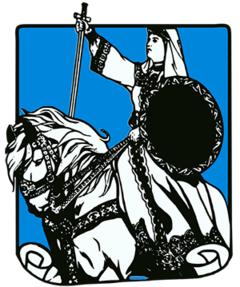Party of Freedom
Party of Freedom Partito della Libertà | |
|---|---|
 | |
| Abbreviation | PdL |
| Leader | Beatrice Albini |
| Founded | 1908 |
| Dissolved | 1939 |
| Succeeded by | "Constructive" conservatives |
| Ideology | |
| Political position | Centre-right |
| Colours | Azure |
The Party of Freedom (Italian: Partito della Libertà, abbreviated PdL) was a liberal conservative political party in Alscia.
Led by Beatrice Albini, the PdL was moderately conservative and economically liberal. Due to the FPP already gaining Hannaist voters through the NUP and NLP, the PdL found a niche representing non-Gylic interests, and was known for its defense of religious freedom.
It formed the official opposition in the Legislative Council throughout its existence.
History
The PdL was founded in 1908, after the organisation of Alscia as a province of the Cacertian Empire. The name was chosen in tribute to the Cacertian liberation, and its initial profile was broadly Hannaist conservative. Indeed, Hannah Edelstein was one of its founders, and became its elder stateswoman.
It won 5 seats in the Legislative Council in 1908, forming the official opposition to the Donatella Rossetti government. In the local elections the same year, it won the most seats of any party, a feat it would repeat at all subsequent local elections.
A central weakness of the PdL in Alscia was that the FPP had already attracted a significant part of the Hannaist vote, through the pragmatism of the NUP and NLP. In response, it gradually defined itself as a a liberal conservative party, supportive of reformism but appealing to voters who disagreed with the FPP's aggressive socio-economic interventionism.
The PdL's greatest asset was its leader Beatrice Albini. Refined, intellectual, and fluently bilingual in Italian and French, Beatrice was an effective campaigner and a popular politician, being more recognised than her party. She was popularly known as Zia Beatrice ("Aunt Beatrice") and Splendida Baronessa ("Splendid Baroness", after being awarded the title by the UOC).
She had a good working relationship with Governor Donatella Rossetti, and was seen by the public and media as Donatella's amenable offsider. The partnership allowed Beatrice to secure the passage of PdL-friendly legislation, particularly in the FPP's earlier years when the NUP–NLP–PRRA liberal bloc outnumbered the leftist SP–SDP.
During the 1920s, the PdL took a hostile stance towards the new PCA and PFA, reserving most of its hostility for the Futurists. Beatrice supported the Megelanese opposition and exile community, welcomed Enrico Grolli's daughter Edda into the party, and often spoke in the Council in condemnation of the Futurist regime.
The PdL ceased to exist when Alscia joined the Free Territories in 1939. The majority of its members remained active in Free Territories politics, becoming part of the "constructive" current.
Ideology
The PdL was a conservative and liberal party. It was broadly progressive and supportive of reformism, but skeptical of radical change.
It was economically liberal, opposed to laissez faire and critical of Donatellist economic interventionism.
It was supportive of social reform, feminism, workers' rights, and the cooperative movement.
It was committed to defending minority rights. Notably, it criticised the government's anti-monotheist policies and called for religious tolerance. It drew significant support from Megelanese Italians in Alscia, and was sometimes likened by observers to a cathar democrat or dulcinian democrat party.
Symbols
The party used the colour azure and the symbol of a female horse rider holding a shield and sword, representing the kyðoi who fought against Xevdenite rule.
Election results
Legislative Council of Alscia
| Election | FPV | % | Seats | ± | Government |
|---|---|---|---|---|---|
| 1908 | 34.060 | 15,5% | 5 / 70
|
Official opposition | |
| 1912 | 46.428 | 14,2% | 3 / 70
|
Official opposition | |
| 1916 | 69.461 | 16,1% | 4 / 70
|
Official opposition | |
| 1920 | 79.665 | 15,3% | 3 / 70
|
Official opposition | |
| 1924 | 84.857 | 14,6% | 3 / 70
|
Official opposition | |
| 1928 | 91.549 | 14,2% | 1 / 70
|
Official opposition | |
| 1932 | 122.664 | 16,8% | 4 / 70
|
Official opposition | |
| 1936 | 144.430 | 18,0% | 5 / 70
|
Official opposition |
Local elections
| Election | FPV | % | Councillors | ± |
|---|---|---|---|---|
| 1908 | 45.037 | 20,1% | 40 / 240
|
|
| 1910 | 58.616 | 20,4% | 60 / 350
|
|
| 1912 | 66.610 | 20,2% | 60 / 350
|
|
| 1914 | 78.726 | 20,5% | 70 / 350
|
|
| 1916 | 89.738 | 20,8% | 100 / 480
|
|
| 1918 | 96.210 | 20,7% | 99 / 480
|
|
| 1920 | 107.733 | 21,0% | 116 / 550
|
|
| 1922 | 120.152 | 21,5% | 118 / 550
|
|
| 1924 | 123.994 | 21,2% | 117 / 550
|
|
| 1926 | 131.200 | 21,4% | 139 / 650
|
|
| 1928 | 134.745 | 20,9% | 136 / 650
|
|
| 1930 | 141.414 | 20,6% | 148 / 720
|
|
| 1932 | 154.220 | 21,1% | 152 / 720
|
|
| 1934 | 166.747 | 21,8% | 147 / 720
|
|
| 1936 | 176.525 | 22,0% | 185 / 840
|
|
| 1938 | 184.417 | 22,2% | 186 / 840
|
